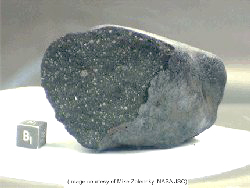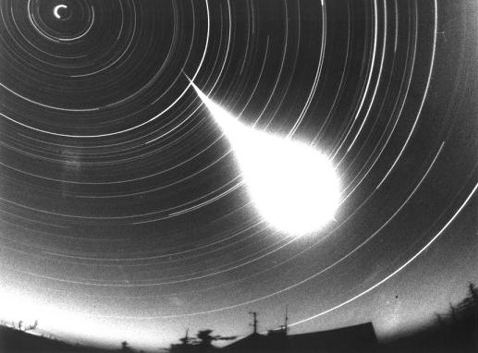Movie of natural fireball (Taurid from 2001 Leonid MAC mission. Courtesy: Peter Jenniskens)

The January 18, 2000, Tagish Lake fireball over Yukon Territories and British Columbia, Canada, left this debris cloud in its wake that was long seen in twilight from scattered sunlight.
ASTROBIOLOGY
Natural impacts of meter-sized asteroids are extremely rare and unanounced. Their arrival in the atmosphere is heralded by a brilliant flash of light and a burst of sound waves. Nearly all available data come from staring instruments that are used to "listen" for clandestine nuclear tests and rocket launches. No observations have been targeted at the specific aspects of ablation and atmospheric chemistry that are important for evaluating the role of meter-sized bodies in the exogenous delivery of organic matter to Earth at the time of the origin of life.
Meter-sized asteroids (comet fragments of that size are thought to be rare) represent up to a third of exogenous mass influx in today's atmosphere and may well have been the dominant source of organics and water at the time of the origin of life when collisions in the asteroid belt were more frequent. Water entrapped in primitive asteroids have the D/H ratio of our ocean. The importance of this source competes with that from giant impacts, asteroids of ~ 10 km in size, and meteoroids (sizes of ~ 150 micron), the latter the topic of the recent Leonid MAC missions.
The relative importance depends on what type and how efficient organic molecules are delivered to the Earth environment. The physical conditions in the three sources are very different, with giant impacts resulting in high-pressure, high-temperature, shock waves that destroy most or the organic matter. Meteoroids are too small to form shocks, and their organic matter is ablated as a haze or large molecules. Giant meteors, or fireballs, that result from the impact of meter-sized asteroids deposit 99.9% of mass in the Earth˙ýs atmosphere in a complex process of ablation, spallation, and shock chemistry. The organic matter in the asteroids is deposited in the atmosphere in the form of atoms, small molecules, large molecules, soot, and dust. Carbon atoms and molecules will react chemically with the atmosphere in the shockwave and wake, which will result in organic compounds enriched in functional groups that are different from those found in meteorites.
 The Tagish Lake meteorite is rich in carbonaceous compounds, some of which survived ablation and ended up on the ground (on a frozen lake bed).
The Tagish Lake meteorite is rich in carbonaceous compounds, some of which survived ablation and ended up on the ground (on a frozen lake bed).
A tiny fraction of these asteroids survive in the form of meteorites, which can be studied in the laboratory. Although meteorites give information on the initial composition of the organic matter and it˙ýs association with minerals and water, such studies do not address what happens to the bulk of the organic matter in the Giant Meteor phase that is left in the wake and the debris cloud. Many micrometeorites suggest an asteroidal origin, but it is unclear if they result from large or small meteors. Organic molecules and soot are quickly dispersed and blend with our present day natural environment. Laboratory experiments of meteorite ablation can mimick, but do not reproduce exactly, the physical conditions in natural fireballs. In particular, it is impossible to reproduce both the heat flux to the surface from radiation generated just behind the shock and from convective flow at the same time.












 The Tagish Lake meteorite is rich in carbonaceous compounds, some of which survived ablation and ended up on the ground (on a frozen lake bed).
The Tagish Lake meteorite is rich in carbonaceous compounds, some of which survived ablation and ended up on the ground (on a frozen lake bed).